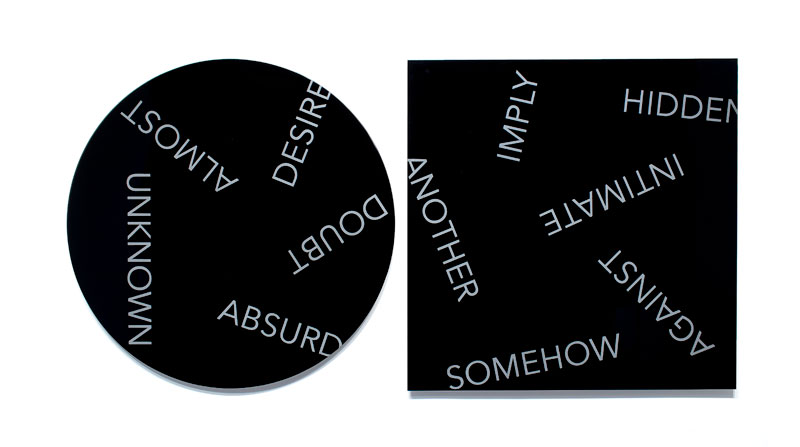
Square: 30 x 30 inches (76.2 x 76.2 cm)
Circle: 30″ diameter (76.2 cm)
Signed and dated on accompanied certificate
(Inventory #29251)
Exhibited September 16, 2017 – November 4, 2017
Square: 30 x 30 inches (76.2 x 76.2 cm)
Circle: 30″ diameter (76.2 cm)
Signed and dated on accompanied certificate
(Inventory #29251)
Exhibited September 16, 2017 – November 4, 2017
Robert Barry has created a new etched mirror diptych – black glass mirror – a 30 inch square juxtaposed with a 30 inch circle, each with text that varies in orientation. Each panel consists of complete words, incomplete words (as they would extend over the edges of the mirror), specific words (e.g. “desire”) and open-ended words (e.g. “almost”). Partly a formal study in comparison (square versus circle, reflective (background) versus opaque (etched text), specific versus general, this work also provides the space among these relationships so as to create a grey space where answers and meanings are not hard, fast or fully defined, but where one can question strict logic and allow for poetic feeling, meaning and opportunity.
In terms of the artist’s history, Robert Barry’s first solo museum exhibition was in 1971 at The Tate in London and over the years he has proceeded to have solo exhibitions at the Stedelijk in Amsterdam, the Folkwangmuseum Essen in Germany, the former Museum of Conceptual Art in San Francisco, the Musée St. Pierre, Art Contemporain in Lyon, France, the Haags Gemeentemuseum in Den Haag, Netherlands, the Dum Umeni Brno in the Czech Republic, and the Kunsthalle Nurnberg among others. Group exhibitions with Barry’s work have taken place at the Guggenheim Museum in New York, Seattle Art Museum, Jewish Museum, Kyoto Museum of Fine Arts, Museum of Modern Art in New York, among hundreds of others. His works are in the collections of the Whitney Museum of American Art, New York, NY, Van Abbemuseum, Eindhoven, Stedelijk Museum, Amsterdam, Panza Collection, Varese, Ludwig Collection, Cologne, Museum of Modern Art, New York, Hirshorn Museum and Sculpture Garden, Washington D.C., Musee National d’Art Moderne, Centre George Pompidou, Paris, Kunstmuseum Basel, Basel, National Gallery of Art, Washington, D.C., The Solomon R. Guggenheim Museum, New York, Museum für Monderne Kunst Frankfurt am Main, Frankfurt, Germany, Museum of Contemporary Art Los Angeles, Los Angeles, and the Musée d’Orsay, Paris, among many others.
Robert Barry is an American artist who currently lives and works in Teaneck, New Jersey. Since 1967, Barry has produced non-material works of art, installations, and performance art using a variety of otherwise invisible media. In 1968, Robert Barry is quoted as saying “Nothing seems to me the most potent thing in the world.”
Barry was born in 1936 and grew up in The Bronx. A graduate of Hunter College, he studied there under artists William Baziotes and Robert Motherwell, later going to the college’s faculty. Barry moved to Teaneck in1974.
Barry’s work focuses on escaping the previously known physical limits of the art object in order to express the unknown or unperceived. Consequently, Barry has explored a number of different avenues toward defining the usually unseen space around objects, rather than producing the objects themselves.
Major nonvisible works from his early period include Carrier Wave, in which Barry used the carrier waves of a radio station for a prescribed length of time “not as a means of transmitting information, but rather as object.” Radiation Piece, and Inert Gas Piece, in which Barry opened various containers of inert gases in different settings before groups of spectators, such as a canister of helium released in a desert.
Barry’s work has been shown in international events such as the Paris Biennale (1971), Documenta, Kassel (1972), and the Venice Biennale (1972). he is included in the permanent collections of renowned museums including the Museum of Modern Art, New York, the Hirshhorn Museum and Sculpture Garden, Washington, D.C.; the Solomon R. Guggenheim Museum, New York; the Musée National D’Art Moderne, Centre Georges Pompidou, Paris; the Museum of Contemporary Art, Los Angeles and the National Gallery of Art, Washington, D.C.
10 Newbury Street, Boston, Massachusetts 02116
617-262-4490 | info@krakowwitkingallery.com
The gallery is free and open to the public Tuesday – Saturday, 10am – 5:30pm